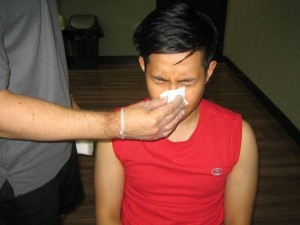Nasal trauma involves damage to the nose or areas bordering and supporting the nose. External and internal injuries can result to nasal trauma. Remember that the position of the nose puts the nasal cartilage, bones and soft tissues prone to external injuries.
Common forms of nasal trauma
- Fractures
- Nosebleed
- Chemical irritation or injuries to the interior of the nose
- Obstruction by a foreign object
What are the indications?

The signs of nasal trauma range from minor to severe which is based on the form and seriousness of the injury. The usual signs of nasal trauma include:
- Nose pain either inside or bordering area
- Drainage of blood from the nose
- Clear fluid that seeps from the nose
- Bruising around the eye
- Difficulty breathing via the nose
- Swollen face especially around the nasal region
- Disfigurement in the shape of the nose
- Loss of sense of smell
Management of nasal trauma
Generally, a minor case of nasal trauma can be treated at home. In some cases, medical attention is required. The treatment plan suggested by the doctor tend to vary depending on the type and seriousness of the trauma. Some of the options include:
- Medications
- Packing or cauterization
- Surgery
First aid care
For a minor nosebleed, the following must be done:
- The individual must sit upright and lean forward to lessen the blood pressure within the nose
- Hold both nostrils at the soft region for 5-15 minutes
- While these steps are done, the individual should breathe via the mouth and keep the head slightly higher than the heart. Avoid blowing or picking the nose for several hours after.
Quick Note / Disclaimer
The material posted on this page on nasal trauma is for learning and educational purposes only. To learn more about the causes and how it is managed, register for a first aid and CPR course with Ottawa First Aid.
